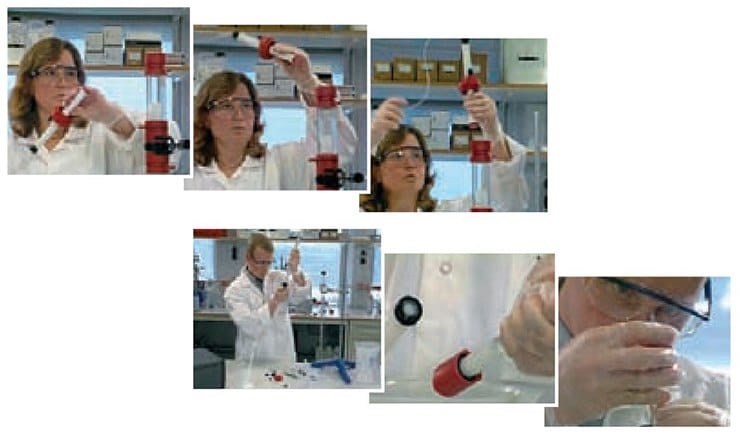Column Packing and Preparation Protocol for Affinity Chromatography
Prepacked columns from Cytiva will ensure reproducible results and the highest performance. However, if column packing is required, the following guidelines will apply at any scale of operation:
- With a high binding capacity medium, short, wide columns can be used for rapid purifcation, even with low linear flow rates.
- Ready to use affnity media are supplied with details of the binding capacity per ml of medium. Unless otherwise stated, estimate the amount of medium required to bind the target molecules and use two- to fve times this amount to pack the column. Refer to the product instructions for more specifc information regarding buffers, flow rates etc.
- For affnity media made from pre-activated matrices, determine the binding capacity of the medium. Estimate the amount of medium required to bind the target molecules and use two- to five times this amount to pack the column.
Affnity media can be packed in either Tricorn™ or XK columns available from Cytiva. A step-by-step demonstration of column packing can be seen in “The Movie”, available in CD format (see Ordering Information).

1. Equilibrate all materials to the temperature at which the separation will be performed.
2. Eliminate air by flushing column end pieces with the recommended buffer. Ensure no air is trapped under the column net. Close column outlet leaving 1–2 cm of buffer in the column.
3. Gently resuspend the medium.
For media not supplied in suspension, use a medium: buffer ratio of approximately 1:2 to produce a suspension for mixing during rehydration.
Avoid using magnetic stirrers since they may damage the matrix.
4. Estimate the amount of slurry (resuspended medium) required on the basis of the recommendations supplied.
5. Pour the required volume of slurry into the column. Pouring down a glass rod held against the wall of the column will minimize the introduction of air bubbles.
6. Immediately fll the column with buffer.
7. Mount the column top piece and connect to a pump.
8. Open the column outlet and set the pump to the desired flow rate.
If the recommended flow rate cannot be obtained, use the maximum flow rate the pump can deliver.
Do not exceed the maximum operating pressure of the medium or column.
9. Maintain the packing flow rate for at least 3 column volumes after a constant bed height is obtained. Mark the bed height on the column.
Do not exceed 75% of the packing flow rate during any purifcation.
10. Stop the pump and close the column outlet. Remove the top piece and carefully fll the rest of the column with buffer to form an upward meniscus at the top.
11. Insert the adaptor into the column at an angle, ensuring that no air is trapped under the net.
12. Slide the adaptor slowly down the column (the outlet of the adaptor should be open) until the mark is reached. Lock the adaptor in position.
13. Connect the column to the pump and begin equilibration. Re-position the adaptor if necessary.
The medium must be thoroughly washed to remove the storage solution, usually 20% ethanol. Residual ethanol may interfere with subsequent procedures.
Many media equilibrated with sterile phosphate-buffered saline containing an antimicrobial agent may be stored at +4 °C for up to 1 month, but always follow the specifc storage instructions supplied with the product.
Column Selection
Tricorn™ and XK columns are fully compatible with the high flow rates achievable with modern media and a broad range of column dimensions are available. Columns most suitable for packing affnity media are listed below. In most cases the capacity of the affnity medium and the amount of sample to be purifed will determine the column size required.
Materials
To continue reading please sign in or create an account.
Don't Have An Account?